|
|
||||||||||||||||||||||||||||||||||||||||||||||||||||||||||
|
Please sign my Guestbook and leave feedback |
||||||||||||||||||||||||||||||||||||||||||||||||||||||||||
|
Recent Additions |
||||||||||||||||||||||||||||||||||||||||||||||||||||||||||
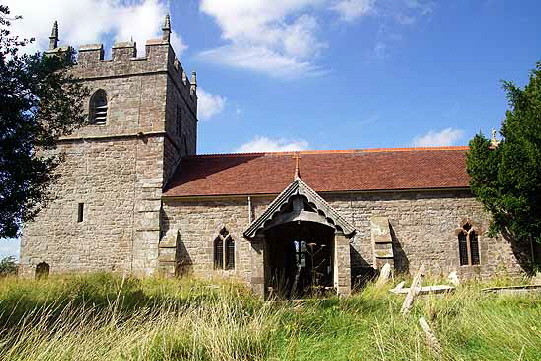 |
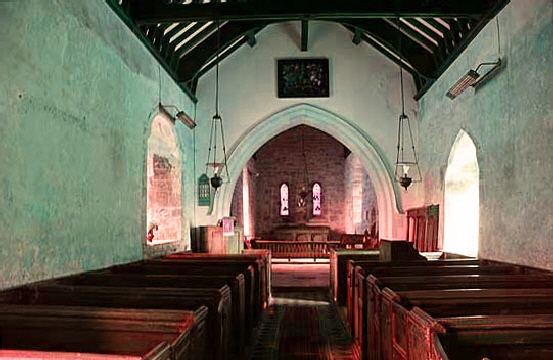 |
|||||||||||||||||||||||||||
|
Left: There is a somewhat wild and unkempt look about Holdgate Church and it begins in the overgrown churchyard with its tumbledown gravestones. This is a church, it seems, that you must take as you find. Its nave and chancel are of a single height which hints at a modernisation program at some point in its history. The south windows look fourteenth century. The porch with its attractive timber barge boards is probably from that date too. The tower is fortress-like and uncompromising. I’m a great sceptic at the many claims that church towers doubled as defensive fortifications (although see A Saunter by the Solway for some that definitely did) but even I have to admit that Holdgate’s has a martial look about it! Right: The interior looking east. “Austere” springs to mind, doesn’t it? The depths of the window rebates speaks to us of Norman solidity. The chancel arch surely dates from the thirteenth century with the double lancet Early English east windows, |
||||||||||||||||||||||||||||
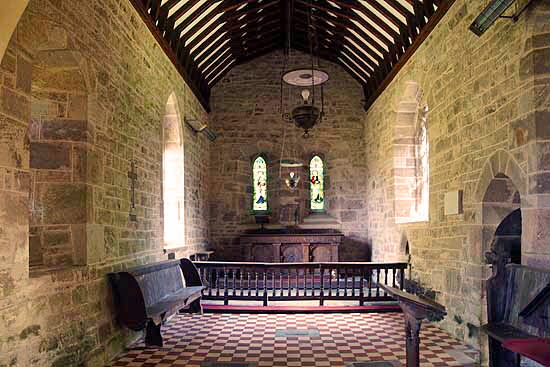 |
||||||||||||||||||||||||||||
 |
||||||||||||||||||||||||||||
|
Left: Looking to the west. The west wall tells us two things. Firstly, it has a Norman window into the tower. This tells us that this was originally the west wall of the church and that the base of the tower can later. Secondly, it tells us that the tower had no defensive function. No such structure would have had its doorway right next to the south door or superfluous openings for attackers to exploit. Not that anybody has claimed this, mind you, as far as I know!. It’s all a bit dilapidated, isn’t it? Right: The chancel has been scraped of its whitewash. I don’t know why only the chancel has been treated in this way but I would say that it was a change for the better, not only because of the parlous state of the plaster and whitewash of the nave but also because the colour and texture of the stonework is rather nice. This, I hasten to add, is not true of many churches the Victorians chose to “scrape”. It is a substantial space with lofty proportions. It almost certainly was shallower and lower in its first version. |
||||||||||||||||||||||||||||
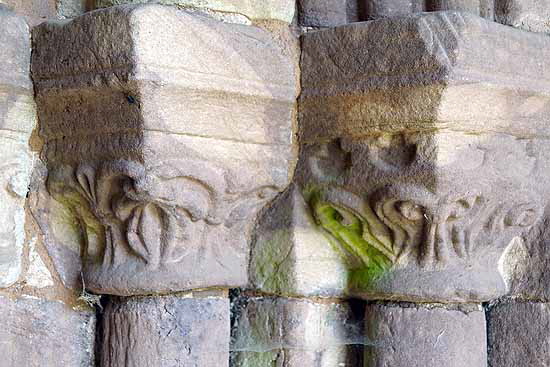 |
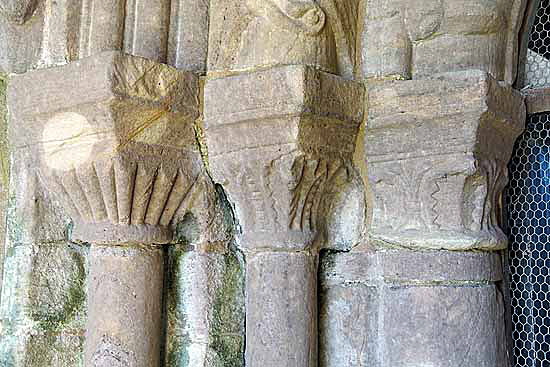 |
|||||||||||||||||||||||||||
|
Left and Right: The south doorway capitals. The decoration is simple but it is interesting to note the substantial difference between the two sides. The west side (right) has rather stiff decoration, whereas the capitals to the east (left) are much more “plastic”. |
||||||||||||||||||||||||||||
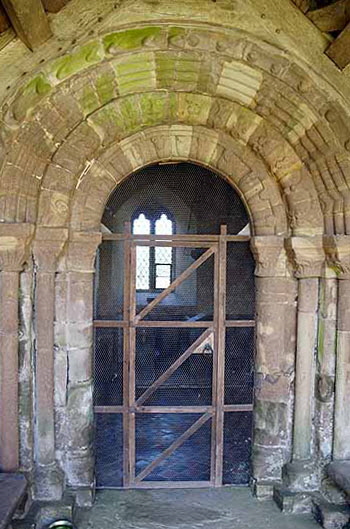 |
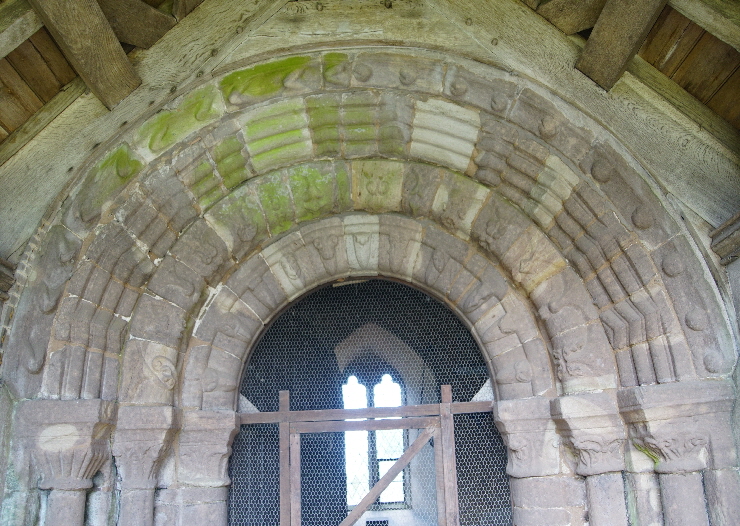 |
|||||||||||||||||||||||||||
|
Left: The south doorway. Right: Detail of the south doorway. The inner course is of the Scandinavian-influenced “beakhead”. Outside that is a course of simply decorative designs. Then we have a rather strange arrangement of ribbing interspersed by the occasional chevron moulding. The drip mould around the outside is also a little odd with arrow head decoration to the left and ball designs to the right of the axis. Taken with the different styles of capitals it appears as if the whole thing was bodged together by more than one mason. |
||||||||||||||||||||||||||||
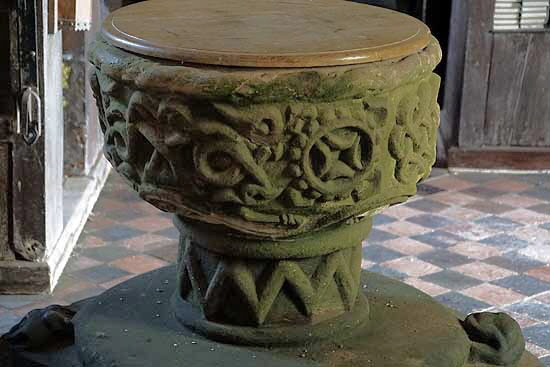 |
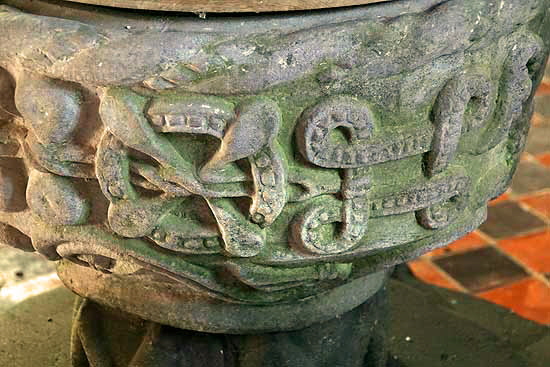 |
|||||||||||||||||||||||||||
|
And so to the most peculiar Norman font. Almost needless to say, some people like to think it was the work of “The Herefordshire School”. For the life of me, I can’t see anything that would make me think so but, much more to the point, neither does Malcolm Thurlby and at the risk of sounding too much in awe of “Font Thurlby” (as I gather he was once called!) on this particular matter if Malcolm says it’s Sunday, it’s Sunday! We will be looking at Stottesdon font next up and that IS Herefordshire School. The only similarity I can see is the use of a roundel on this font where there are several at Stottesdon but really that and a bit of geography are not nearly enough. All that said, this font is a total mystery. It isn’t historiated. It isn’t religious. It isn’t the work of an artistic or sculptural incompetent. The response of those who know a lot about fonts is seemingly to have ignored its existence! There is none of the usual wild speculation. A lot of the decoration is “geometric”. In the picture left we can see a roundel surrounded by ball decoration and a diagonal cross device within. In the picture right is the most intriguing of all: a circle with another diagonal device (the whole looking curiously reminiscent of an aeroplane propeller!) “attached” by a twisted “rope” to a square with looped corners. The pellet pattern within both square and circle is quite ubiquitous in this area. My mind is inevitably (and if you have been looking a lot on this site, predictably) drawn to Mary Curtis Webb’s work on geometrical font decoration. Does the Holdgate font owe anything to neo-Platonic philosophy? It did occur to me that the design to the left of the square looks vaguely like a circle interlaced with arcs but that is probably wishful thinking. The square design looks distinctly Webb-like but her book does not cover it and there is a body of evidence that it was regarded as a good luck symbol throughout northern Europe so it might very well be a Scandinavian “import”. So it all remains a mystery. is it just decoration? Surely not? This meant something to either the sculptor or to some monastic influencer but we cannot know what. |
||||||||||||||||||||||||||||
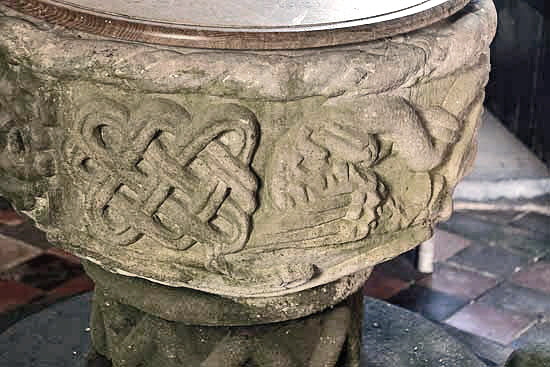 |
||||||||||||||||||||||||||||
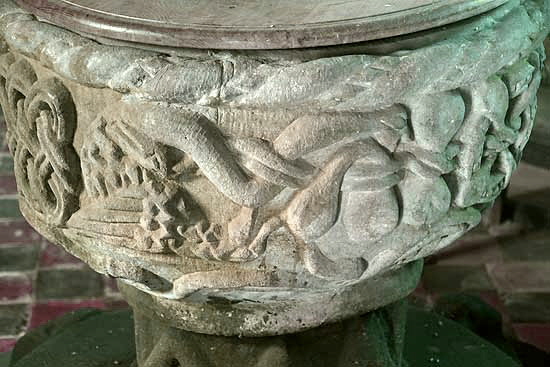 |
||||||||||||||||||||||||||||
|
Left: I can’t make head or tail of this section. There is a serpent there twisting around and about. His head seems to be just right of centre in this picture with an eye and a mouth that looks to be biting on the twisted tendrils that joined together the two geometric sections to the right. To the left is a tangled mess and it isn’t obvious what is at the serpent’s tail, Below it, however, is what rather looks like an inverted angel’s wing. Right: To the left is a section of interlace work that, it must be said, just looks like decorative filler. |
||||||||||||||||||||||||||||
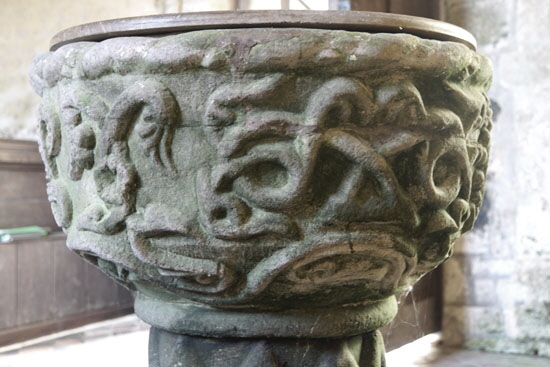 |
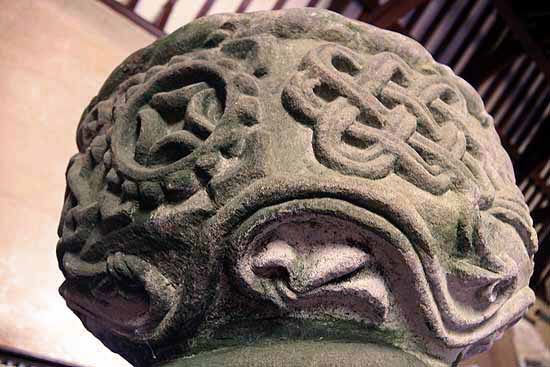 |
|||||||||||||||||||||||||||
|
Left: The area to the left is decorative. The area to the right could be a couple of intertwined serpents (is that an eye bottom left?) but I think it also is decorative. Right: The underside of the goblet is also decorated. |
||||||||||||||||||||||||||||
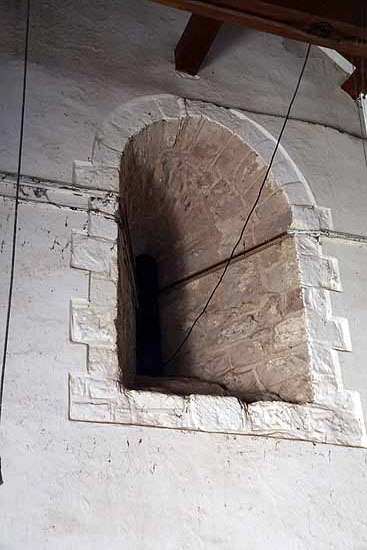 |
||||||||||||||||||||||||||||
 |
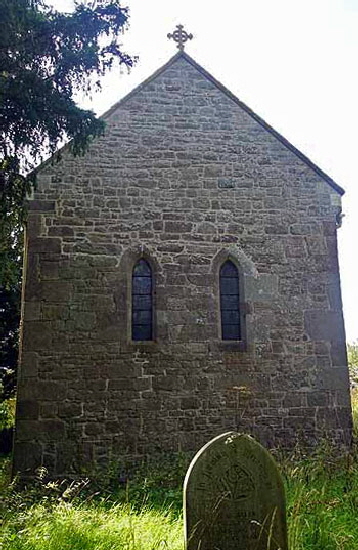 |
|||||||||||||||||||||||||||
|
Left: The splayed Norman west window that now opens into the tower. Centre: One of the box pews. Right: The church from the east end. |
||||||||||||||||||||||||||||
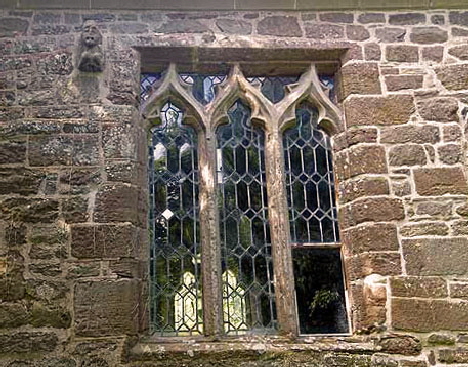 |
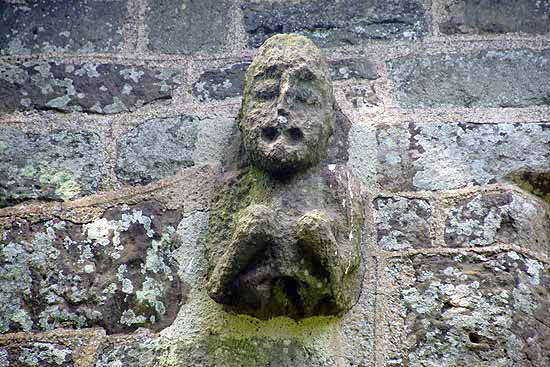 |
|||||||||||||||||||||||||||
|
Left and Right: The Sheela-an-gig is located to the top left of a rectangular window on the south side of the chancel. The Shropshire area is fertile (pun intended) territory for Sheela searchers with others appearing nearby at Tugby and Church Stretton. There are as many theories about Sheela-na-gigs as there are carvings. “Fertility symbol” is the obvious answer. Another popular one is “apotropaia” - by a long way the most pretentious word in the language of church iconography but meaning that they were intended to ward off evil spirits. That is a stock answer for almost any grotesque sculpture on an English church and seems to apply (so some obviously think) for half a millennium. The truth is that there is not one shred of documentary evidence for either of these suggestions. “A mason’s joke” is another favourite. I am quite sympathetic to that view, not least because I believe that accounts for the plethora of mooning men in my own area. Why, though, would these particular “mason’s jokes” have been preserved so assiduously? Because it is pretty obvious that the Holdgate Sheela was not originally located where it is now. On the other hand, I know of one in Empingham in Rutland - carved at least three hundred years later - that was hidden and surely was intended as a joke. In fact, one of the biggest mistakes we can make is to suppose that artistic motivations do not change over the centuries. Oh lord, some of the explanations for Sheelagh are earnest. People are capable of writing whole tomes on the subject, making parallels with all kinds of obscure places around the globe. That is before you get onto the sexual politics of Sheelah which is a whole new battleground for some. My advice? Just enjoy a bit of good old-fashioned rude fun before someone decides to be offended and demands they are hacked out! |
||||||||||||||||||||||||||||
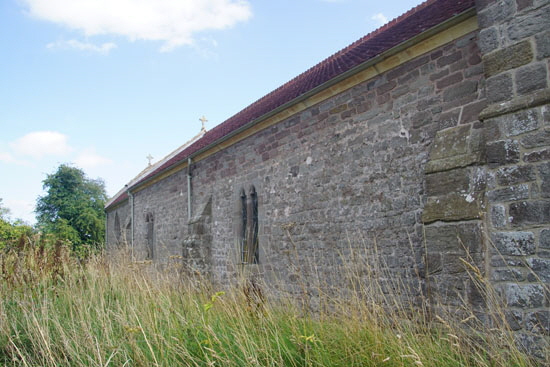 |
||||||||||||||||||||||||||||
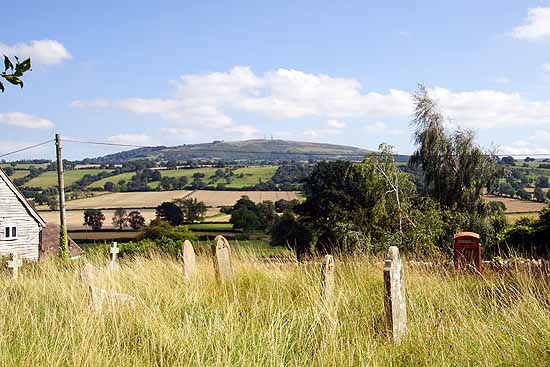 |
||||||||||||||||||||||||||||
|
Left: If the south side is unkempt, the north side is positively unloved. If the north side is the “devil’s side” then Old Nick will be loving Holdgate because it seems to have been left to him lock stock and barrel! Right: Looking out over the south side of the churchyard. That’s the thing about this church trail: the sumptuous scenery comes included. |
||||||||||||||||||||||||||||